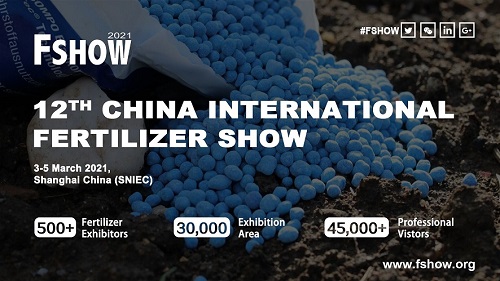
Exhibition time: 17-19 March, 2026 Shanghai, China
 中文
中文

Exhibition time: 17-19 March, 2026 Shanghai, China
 中文
中文
MICRONUTRIENT NUTRITION
Through increased use of soil testing and plant analyses, micronutrient deficiencies have been verified in many soils. Some reasons limiting the incidental additions of micronutrients include:
1. High-yield crop demands remove micronutrients from the soil
2. Increased use of high-analysis NPK fertilizers containing lower quantities of micronutrient contaminants
3. Advances in fertilizer technology reduce the residual addition of micronutrients.
These factors contribute to the significant increase in usage of and need for micronutrients in order to achieve full balanced nutrition.
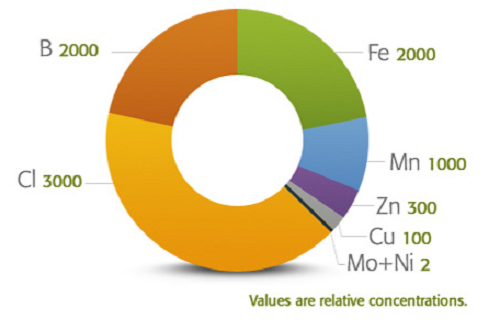
Micronutrients are just as important as macronutrients, but the amount required is very small. Source: IPNI
BORON
Boron (B) exists primarily in soil solutions as the BO₃⁻³ anion – the form commonly taken up by plants. One of the most important micronutrients affecting membrane stability, B supports the structural and functional integrity of plant cell membranes. Boron-deficiency symptoms first appear at the growing points, and certain soil types are more prone to boron deficiencies.
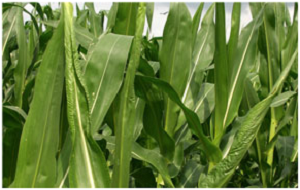
Boron deficiency in corn.
COPPER
Copper (Cu) activates enzymes and catalyzes reactions in several plant-growth processes. The presence of copper is closely linked to Vitamin A production, and it helps ensure successful protein synthesis.

Copper deficiency in wheat.
IRON
Iron (Fe) is essential for crop growth and food production. Plants take up Fe as the ferrous (Fe²⁺) cation. Iron is a component of many enzymes associated with energy transfer, nitrogen reduction and fixation, and lignin formation.
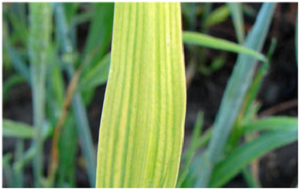
Iron deficiency in wheat.
MANGANESE
Manganese (Mn) functions primarily as part of enzyme systems in plants. It activates several important metabolic reactions and plays a direct role in photosynthesis. Manganese accelerates germination and maturity while increasing the availability of phosphorus (P) and calcium (Ca).
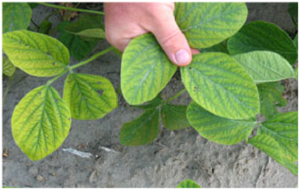
Manganese deficiency in soybeans.
MOLYBDENUM
Molybdenum (Mo) is a trace element found in the soil, and is required for the synthesis and activity of the enzyme nitrate reductase. Molybdenum is vital for the process of symbiotic nitrogen (N) fixation by Rhizobia bacteria in legume root modules. Considering molybdenum’s importance in optimizing plant growth, it's fortunate that Mo deficiencies are relatively rare in most agricultural cropping areas.
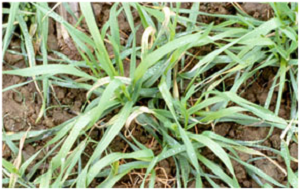
Molybdenum deficiency in wheat.
ZINC
Zinc (Zn) is taken up by plants as the divalent Zn⁺² cation. It was one of the first micronutrients recognized as essential for plants and the one most commonly limiting yields. Although Zn is required only in small amounts, high yields are impossible without it.
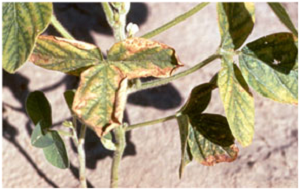
Zinc deficiency in soybeans.
CHLORINE
Plants take up chlorine (Cl) as the chloride (Cl-) anion. It’s active in energy reactions in the plant. Most Cl- in soils comes from salt trapped in parent materials, marine aerosols and volcanic emissions. Classified as a micronutrient, Cl- is required by all plants in small quantities.
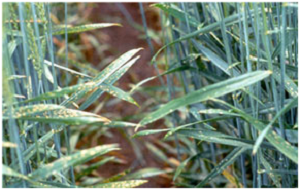
Chloride deficiency in wheat.
NICKEL
Nickel (Ni) was added to the list of essential plant nutrients late in the 20th century. Nickel is important in plant N metabolism because it is a component of the urease enzyme. Without the presence of Ni, urea conversion is impossible. It is required in very small amounts, with the critical level appearing to be about 1.1 ppm.

Nickel deficiency in pecans.
CROP RESPONSE TO MICRONUTRIENTS
Plants differ in their requirements for certain micronutrients. The table at right shows the estimate of the relative response of selected crops to micronutrients. The ratings of low, medium and high are used to indicate the relative degree of responsiveness.
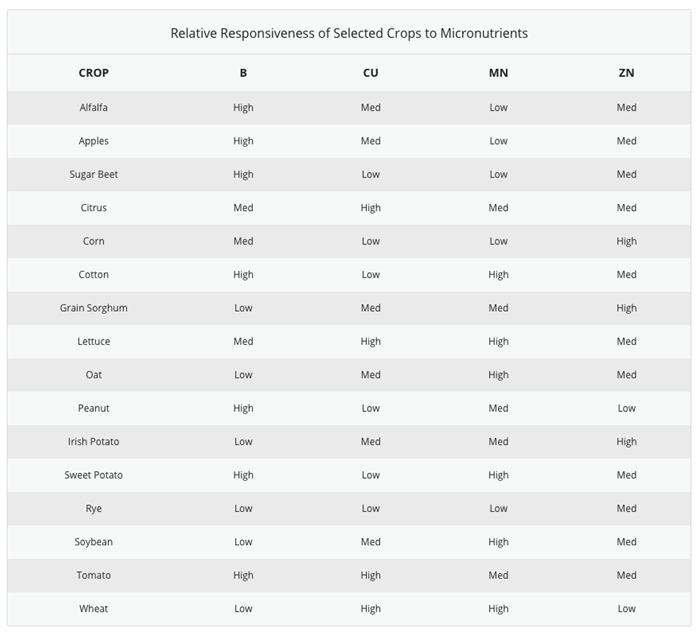
APPLICATION WITH MIXED FERTILIZERS
The most common method of micronutrient application for crops is soil application. Recommended application rates usually are less than 10 lb/acre (on an elemental basis), so uniform application of micronutrient sources separately in the field is difficult. Therefore, both granular and fluid NPK fertilizers are commonly used as carriers of micronutrients. Including micronutrients with mixed fertilizers is a convenient method of application, and allows more uniform distribution with conventional application equipment. Costs are also reduced by eliminating a separate application. Four methods of applying micronutrients with mixed fertilizers are:
1. Incorporation with granular fertilizers: Incorporation during manufacture results in uniform distribution of micronutrients throughout granular NPK fertilizers
2. Bulk blending with granular fertilizers: Bulk blending produces fertilizer grades that provide the recommended micronutrient rates. Unfortunately, nutrient segregation is common, resulting in uneven nutrient distribution
3. Coating onto granular fertilizers: Coating powdered micronutrients onto granular NPK fertilizers decreases the possibility of segregation
4. Mixing with fluid fertilizers: Mixing micronutrients with fluid fertilizers has become a popular method of application. Keep in mind, compatibility tests should be made before tank-mixing operations of micronutrients with fluid fertilizers are attempted. Suspension fertilizers are used as micronutrient carriers as well.
FOLIAR SPRAYS
Foliar sprays are widely used to apply micronutrients, especially iron and manganese, for many crops. Soluble inorganic salts generally are as effective as synthetic chelates in foliar sprays, so the inorganic salts usually are chosen because of lower costs. Suspected micronutrient deficiencies may be diagnosed with foliar spray trials with one or more micronutrients, but tissue sampling is the most common method to determine deficiencies during the growing season. Correction of deficiency symptoms usually occurs within the first several days, and then the entire field could be sprayed with the appropriate micronutrient source. Inclusion of sticker-spreader agents in the spray is suggested to improve adherence of the micronutrient source to the foliage. Caution should be used because of leaf burn due to high salt concentrations or inclusion of certain compounds in foliar sprays.
ADVANTAGES OF FOLIAR SPRAYS
1. Application rates are much lower than rates for soil application
2. Uniform application is easily obtained
3. Response to the applied nutrient is almost immediate, so deficiencies can be corrected during the growing season.
DISADVANTAGES OF FOLIAR SPRAYS
1. Leaf burn may result if salt concentrations of the spray are too high
2. Nutrient demand often is high when the plants are small and leaf surface is insufficient for foliar absorption
3. Maximum yields may not be possible if spraying is delayed until deficiency symptoms appear
4. There is little residual effect from foliar sprays
5. Application costs are higher if more than one spray is needed unless they can be combined with pesticide spray applications.
MICRONUTRIENT RATES
BORON
Recommended application rates of boron are rather low (0.5 to 2 lb/acre), but should be carefully followed because the range between boron deficiency and toxicity in most plants is narrow. Uniform application of boron in the field is very important for the above reason. Boronated NPK fertilizers (those containing boron sources incorporated at the factory) will ensure a more uniform application than most bulk blended fertilizers. Foliar sprays also ensure a rather uniform application, but costs generally are higher.
Soil tests should be included in boron fertilization programs, first to assess the level of available boron, and later to determine possible residual effects (buildup). The most common soil test for boron is the hot-water-soluble test. This test is more difficult to conduct than most other micronutrient soil tests, but most boron response data have been correlated with it.
COPPER
Recommended copper rates range from 3 to 10 lb/acre as CuSO₄ or finely ground CuO. Residual effects of applied copper are very marked, with responses being noted up to eight years after application. Because of these residual effects, soil tests are essential to monitor possible copper accumulations to toxic levels in soils where copper fertilizers are being applied.
Plant analyses also can be used to monitor copper levels in plant tissues. Copper applications should be decreased or discontinued when available levels increase beyond the deficiency range.
IRON
Soil applications of most iron sources generally are not effective for crops, so foliar sprays are the recommended application method. Spray applications of a 3 to 4% FeSO₄ solution at 20 to 40 gallons/acre are used to correct iron deficiencies. The application rate should be high enough to wet the foliage.
More than one foliar application may be required for correction of iron chlorosis. Inclusion of a sticker-spreader agent in the spray is suggested to improve adherence of the spray to the plant foliage for increased iron absorption by the plant.
MANGANESE
Recommended application rates range from 2 to 20 lb/acre of manganese, generally as MnSO₄. Application rates of MnO would be similar if applied as a fine powder or in NPK fertilizers. Band application of manganese sources with acid-forming fertilizers results in a more efficient use of applied manganese because the rate of oxidation of applied manganese to the unavailable tetravalent form (as in MnO₂) is decreased.
There are no residual effects of applied manganese for the same reason, so annual applications are needed. Foliar spray applications of MnSO₄ also are used and require lower rates than soil applications.
MOLYBDENUM
Recommended molybdenum rates are much lower than those for the other micronutrients, so uniform application is very important. Broadcast application of molybdenized phosphate fertilizers prior to planting or to pastures has been used to correct molybdenum deficiencies. Soluble molybdenum sources also can be sprayed on the soil surface before tillage to obtain a uniform application.
Seed treatment is the most common method of molybdenum application. Molybdenum sources are coated onto the seed with a sticking agent and/or conditioner. This method ensures a uniform application, and sufficient amounts of molybdenum can be seed coated to provide sufficient molybdenum.
ZINC
Recommended rates of zinc generally range from 1 to 10 lb/acre. Band or broadcast applications are used, but foliar applications also are effective. Band applications of zinc sources with starter fertilizers is a common practice for row crops. Foliar sprays of a 0.5% ZnSO₄ solution applied at a rate of 20 to 30 gallons/acre also will supply sufficient zinc, but several applications may be necessary.
As with copper, residual effects of applied zinc are substantial, with responses found at least 5 years after application. Because of these residual effects, soil test levels of available zinc generally increase after several applications. Many states have reduced their recommended zinc application rates because of these residual effects.
From "The Efficient Fertilizer Use Manual", Micronutrients chapter by Dr. John Mortvedt
